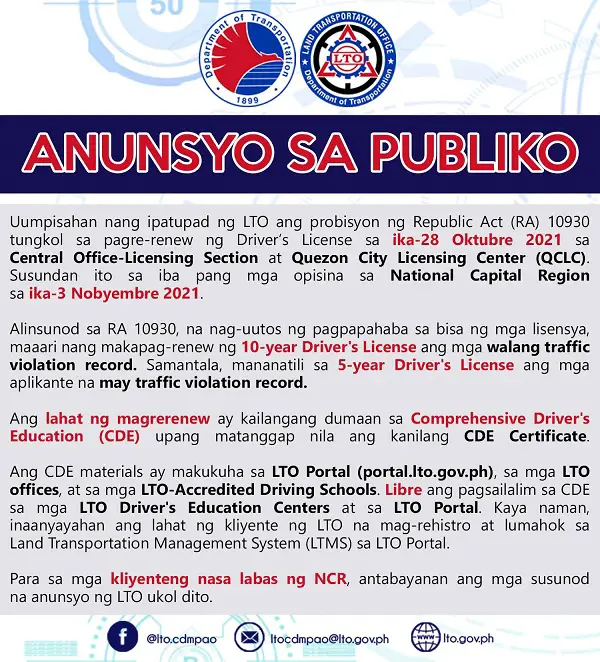LTO Driver’s License Requirements and Application 2025
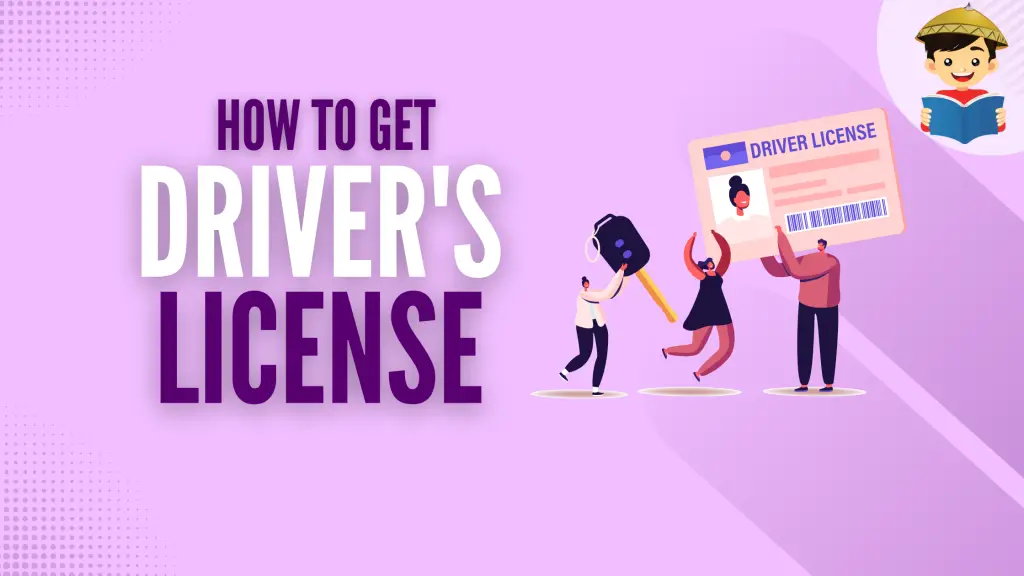
Owning a driver’s license comes with a lot of responsibilities.
You’re responsible for your safety and the safety of your passengers and other vehicles around you.
It’s the main reason the LTO (Land Transportation Office) requires applicants to submit many documents and pass a series of written and practical driving examinations before getting issued a driver’s license.
This guide will discuss the latest LTO driver’s license requirements and walk you through the process of obtaining a driver’s license quickly and efficiently.
Table of Contents
What Is a Driver’s License?
A driver’s license is a government-issued document that can give you the proper authority to drive a motor vehicle in the Philippines.
Related: The Ultimate List of Philippine Valid IDs
How Long Is the Validity of the Philippine Driver’s License?
It has a validity of five (5) years, while the student permit is only valid for one (1) year. Upon renewal, however, the driver’s license validity period can be extended to 10 years1 provided that the driver didn’t incur any record of a road traffic violation.
The 10-year license incentive will be granted to responsible drivers with clean records beginning in October 2021. On the other hand, drivers with at least one recorded traffic violation are only eligible for a 5-year valid license.
Both the holders of 10-year and 5-year valid driver’s licenses used to be required to undergo Periodic Medical Examinations (PME) during the validity of their licenses2. This ensures that the licensee will remain medically qualified to operate a motor vehicle throughout the validity of the driver’s license.
However, LTO chief Art Jay Tugade amended the LTO Memorandum 2021-2285 (i.e., the supplemental Implementing Rules and Regulations of Republic Act 10930) to remove the Periodic Medical Examination as a requirement for holders of licenses with five to ten years validity3.
As a result of this amendment, drivers with five- to ten-year valid licenses will only be required to undergo a medical exam 60 days before or on the specified renewal date. Returning Filipinos from abroad, on the other hand, must undergo a medical examination 30 days after their arrival in the Philippines before they can drive with their licenses.
The scrapping of the Periodic Medical Examination was implemented because no empirical data supports that medical examinations could prevent road crashes.
Is There an Age Limit for Driver’s License Application in the Philippines?
The minimum age for a Student Permit application is 16 years old (if foreigner, 18 years old). Meanwhile, the minimum age for a Non-Professional or Professional Driver’s License application is 17 (if foreigner, 18 years old).
On the other hand, there is no specific maximum age limit for a driver’s license application. As long as you are still physically and mentally able to drive a motor vehicle and meet other qualifications, you can apply for a license regardless of your age4.
Types of Driver’s Licenses in the Philippines
The following are three types of driver’s licenses in the Philippines.
- Student Permit – Everyone who wishes to obtain a Professional or Non-Professional Driver’s License must get a Student Permit first. The Student Permit or Student License authorizes its holder to drive a motor vehicle in the presence of someone with a valid Professional or Non-Professional Driver’s License. The student permit is only valid for one year and cannot be modified, revised, or renewed.
- Non-Professional – A Non-Professional Driver’s License can give you the authority to drive/operate PRIVATE motor vehicles with up to 4,500 GVW (Gross Vehicle Weight). Holders of this license will be able to drive vehicles with both manual and automatic transmissions. Some vehicle types included in the weight limit are sedans, minivans, pickups, SUVs, and other passenger vehicles.
- Professional – A Professional Driver’s License grants the driver (hired or paid) the authority to drive/operate motor vehicles, whether for PRIVATE use or hire to the PUBLIC. Professional Driver’s License holders are permitted to drive almost all vehicles, including motor vehicles exceeding 4,500 GVW, like heavy construction equipment.
How To Get a Student Permit in the Philippines
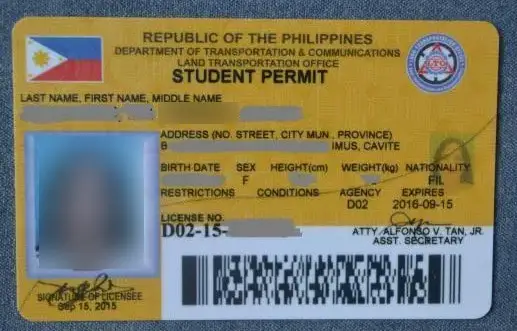
Everyone wishing to obtain a driver’s license must apply for a student permit first. This will give you the authority to drive specific types of vehicles while accompanied by a Professional or Non-Professional Driver’s License holder.
The student permit will allow you to learn to drive for one year before taking written and practical driving examinations. You can apply for a Student Permit at any LTO District Office, Licensing Center, and Extension Office that processes Driver’s License transactions.
Take note that a student permit is NOT an official driver’s license. If you’re caught driving a vehicle without the presence of a trained, licensed driver, you will be fined a penalty fee of ₱3,000 and run the risk of getting your vehicle impounded.
1. Qualifications: Who can apply for a student permit?
According to the latest LTO Citizen’s Charter5, you can apply for a student permit as long as you meet the following qualifications:
- You must be a Filipino citizen, 16 years old and above.
- If you are a foreigner, you must be at least 18 years old, have been staying in the Philippines for at least one month, and has proof of stay for at least six months.
- If you hold a driver’s license that has expired for ten years or more, you are no longer allowed to drive and are required by the LTO to apply for a student permit again.
- You must be able to read and write in English, Filipino, or any applicable local dialect.
- You must be physically and mentally fit to drive a motor vehicle.
- You must have no unsettled traffic violation.
- You must have attended at least 15 hours of theoretical driving lessons from any LTO-accredited driving school.
2. Requirements
a. Basic Requirements
- Duly-accomplished Application for Permits and License (APL) Form (previously known as the Driver’s License Application Form). You can download a copy via the official LTO website.
- PSA-authenticated birth certificate (original and photocopy). Suppose you can’t secure a PSA birth certificate or live in an area with no PSA branch. In that case, you can present the original and submit a photocopy of your birth certificate validated by the Office of the Local Civil Registry (LCR) with an attached Official Receipt; Philippine Identification Card; Passport; or your PSA Certificate of Marriage.
- Original and photocopy of any government-issued ID with photo and signature of the applicant. Government-issued IDs accepted by the LTO include the following: Philippine passport, SSS or UMID Card, Philippine Identification (PhilID) Card, PhilHealth ID, TIN Card, Postal ID, Senior Citizen ID, OFW ID, Voter’s ID, PRC ID, Integrated Bar of the Philippines (IBP) ID, DSWD Certification, Home Development Mutual Fund (HDMF ID), GSIS e-Card, Seaman’s Book, GOCC ID, Voter’s Certification, Solo Parent ID, National Council of Disabled Affairs (NCDA) ID, OWWA ID.
- Taxpayer’s Identification Number or TIN, if you’re employed.
- Medical examination certificate (online only/electronically transmitted by the clinic). Medical certificates of Student Permit applicants should only come from an LTO-accredited clinic or physician6. To save time and avoid long queues, you can get a medical certificate a few days before your date of application. As of this writing, LTO has set a maximum price of ₱3007 for the medical exam; the certificate is valid for two (2) months. No need to provide urine or stool samples as the medical exam will only test/measure your vision, blood pressure, and overall medical condition. Although the clinic is responsible for electronically transmitting the certificate to the LTO, applicants will still be issued a hard copy which they should present on the day of their application.
- Theoretical Driving Course (TDC) certificates (electronically transmitted) to prove that you have completed the required theoretical instruction given by LTO or any LTO-accredited driving schools (here’s the complete list of LTO-accredited driving schools in the Philippines as of September 30, 2021).
b. Additional Requirements
For minors or applicants below eighteen (18) years old:
- Original copy of the duly notarized parent’s consent or an affidavit of the guardian authorizing the applicant to secure/apply for a student permit.
- One valid government-issued ID of consenting parent or guardian with photo and signature (original and photocopy)
For married women:
- PSA-authenticated marriage contract (original and photocopy)
For foreigners:
- Applicant’s passport containing the following (original and photocopy): (a) Entry date of at least one (1) month; and (b) Visa duration of at least six (6) months from the date of application. Or, if born in the Philippines, submit a PSA-authenticated birth certificate (original and photocopy)
3. Fees: How much will applying for a student permit cost?
Applying for a student permit can cost between ₱1,000+ and ₱5,500+. The total amount depends on several factors like the cost of the medical exam (which should cost a maximum of ₱300, as per LTO regulation), where you’ll take the theoretical driving course (driving schools may charge up to ₱4,500 while LTO’s Driver’s Education Center offers it for free or at a lower fee of ₱300+), and whether or not you will get the required birth certificate online or via a walk-in application.
Here’s the breakdown of the fees you’ll need to pay when applying for a student permit:
- Birth certificate: ₱330 to ₱365 (no need to pay for one if you already have an existing copy, or you’ll bring a Philippine passport instead)
- Medical examination: ₱300
- Theoretical Driving Course: FREE to ₱4,500 (average of ₱1,500)
- Student Permit Fee: ₱317.63
4. Step-by-step Guide (Manual/Walk-in Application)
- Before you proceed to an LTO Office and apply for a Student Permit, ensure you have completed a 15-hour face-to-face or online Theoretical Driving Course (TDC); otherwise, your application will not be processed.
- Arrive at the LTO office early. Preferably, choose to transact with an LTO District Office where most applicants are for renewal. For instance, LTO Driver’s License Renewal Office in select malls is usually not crowded and will enable you to finish the application process within a day. You can get your Student Permit in less than 30 minutes if you’re lucky.
- Go to the Customer Service Counter and request an Application for Permits and License (APL) Form and the Requirements Checklist. You’ll also be given a queue number.
- Fill out the application form and prepare the required documents.
- Submit the filled-out application form and other documents with your queue number. The evaluator will check the completeness and authenticity of your application and documents.
- Head to the designated area for the photo/signature taking and wait for your turn.
- The approving officer will review and approve your application.
- Head to the cashier and pay the required fees when your number gets called.
- The releasing clerk will issue your Student Permit as an Official Receipt. After receiving your Student Permit, write your name and signature on the log sheet.
5. Additional notes
- A student permit is only valid for one year. After that, you will no longer be allowed to use it for practical driving courses. Two years from the issuance of SP, the student must get a new permit bearing the same SP number.
- When applying for a student permit (or any driver’s license, for that matter) at any LTO office, avoid wearing shorts and slippers.
- Ideally, get your medical exam at an LTO-accredited clinic that issues two copies of the medical certificate. You won’t have to pay for another medical exam if you apply for a non-pro driver’s license later. After all, the medical certificate is valid for two months, while you can apply for a non-pro about a month after obtaining the student permit.
- Depending on the driving school where you’ll take the theoretical driving course, the program may be divided into either three 5-hour sessions or two sessions (8 hours + 7 hours).
- Again, the newly released memorandum from the LTO reveals you can no longer be issued a Student Driver’s Permit unless you have completed the mandatory theoretical driving course given by LTO or any of its duly accredited driving schools. The driving lessons should be at least 15 hours and must be completed within two years from the start of the course. Aside from classroom/remote learning instruction, each student must also be given a Filipino Driver’s Manual to help reinforce the lessons. This Driver’s Manual can also be accessed in the LTMS under the E-learning tab. To ensure that the driving schools are conducting the classes and to prevent applicants from circumventing the system by bribing their instructors, the LTO will give and install automated logbooks and closed-circuit television (CCTV) cameras in all its accredited driving schools. In addition, the LTO will conduct regular unannounced visits and audits of the said driving schools.
- If you cannot afford a regular driving school, avail of LTO’s free 15-hour Theoretical Driving Course (TDC)8. It covers basic lessons on vehicle operation, traffic signs, and driving etiquette. As of this writing, only the LTO-NCR West office offers the free TDC with limited monthly slots. For any updates on slot availability, visit the LTO-NCR Facebook page.
- A student driver’s permit is usually not accepted as a form of identification because it’s only meant to be a temporary permit. However, in some cases, it can be considered a valid ID if it’s in a card format, like when applying for a passport. It can also be used with the Official Receipt for SSS transactions.
- Thirty-one days (or one month) after the date of student permit issuance, you can start the application process for a Non-Professional Driver’s License. You can no longer apply for a Professional Driver’s License with a Student Permit only. The new policy requires applicants to obtain a Non-Pro License before qualifying for a Pro License.
How To Get a Non-Professional Driver’s License in the Philippines
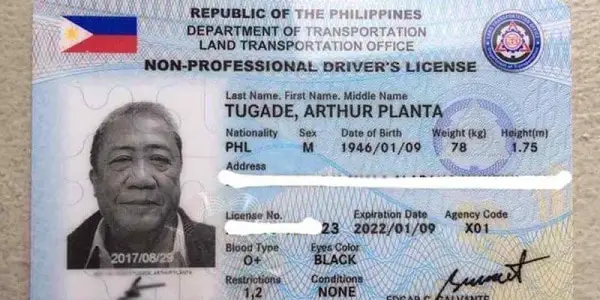
This guide is for individuals planning to apply for a Non-Professional Driver’s License, a license applicable to individuals driving motorcycles and vehicles with up to 4,500 GVW (Gross Vehicle Weight).
The Non-Professional Driver’s License is an official license that will only enable you to drive private vehicles. If you want to earn money driving public cars, apply for a Professional Driver’s License instead.
Applications for a new Non-Professional Driver’s License can be submitted at any LTO District Office, Licensing Center, and Extension Office that processes Driver’s License transactions.
1. Qualifications: Who can apply for a Non-Professional Driver’s License?
As per the latest LTO Citizen’s Charter, you can apply for the Non-Professional Driver’s License if you meet the following qualifications:
- You must be a Filipino citizen at least seventeen (17) years old.
- You must be at least eighteen (18) years old if you are a foreigner.
- You must be physically and mentally able to drive a motor vehicle. However, just because you have a medical condition doesn’t mean you’ll be barred entirely from driving a car. Depending on the physician who will assess you during the medical examination, you may be allowed to drive a vehicle if the appropriate condition code is added to your driver’s license.
- You must be able to read and write English, Filipino, or any applicable local dialect.
- You must hold a valid Student Permit issued at least one month before the Non-Professional Driver’s License application.
- You must have no unsettled traffic violation.
- If you’re a holder of an expired foreign driver’s license or a Non-Professional driver’s license that has expired for more than two years, you’re not qualified to renew anymore and must apply for a new one.
- You must have completed at least 8 hours of practical driving lessons given by an LTO-accredited and TESDA-certified driving school (LTO will offer the same services but at a lower rate for those who cannot afford to enroll in a driving school). This additional qualification is part of a new LTO policy implemented in early 2020. According to the Memorandum Circular No. 2019-2176, new driver’s license applicants are now required to complete a minimum of 8 hours of hands-on driving instruction that will teach student drivers how to competently operate a motor vehicle through lessons on start and stop; parking; road crossing and light traffic; backing and turning; maneuvering; highway driving; garage driving; night driving; and heavy traffic. This new program is part of the LTO’s vision to prevent, if not eliminate, road accidents by issuing licenses only to those capable of driving.
- Must have passed the required written and practical exam after completing the 8-hour practical driving course.
2. Requirements
a. Basic Requirements
- Duly-accomplished Application for Permits and Licenses or APL Form (previously known as Driver’s License Application Form or ADL Form). Original copy of valid Student Permit issued at least one month before the date of application.
- Original copy of valid Student Permit issued at least thirty-one(31) days before the date of application
- Taxpayer’s Identification Number or TIN, if you’re employed
- Medical examination certificate (online only/electronically transmitted by the clinic). Medical certificates of Non-Professional Driver’s License applicants should only come from an LTO-accredited clinic or physician. To save time and avoid long queues, you can get a medical certificate a few days before your date of application. As of this writing, the medical certificate costs ₱300 and is valid for two (2) months. No need to provide urine or stool samples as the medical exam will only test/measure your vision, blood pressure, and overall medical condition. Although the clinic is responsible for electronically transmitting the certificate to the LTO, applicants will still be issued a hard copy which they should present on the day of their application.
- Practical Driving Course (PDC) certificates (electronically transmitted) to prove that you have completed the required practical instruction given by LTO or any LTO-accredited driving schools (here’s the complete list of LTO-accredited driving schools in the Philippines as of September 30, 2021). Starting August 3, 2020, new driver’s license applicants, whether Professional or Non-Professional and whose student permits were issued from August 3, 2020 onwards, are now required to submit their certificates electronically to the LTO-IT system, or else their applications will not be processed. The driving school is responsible for sending the certificate to the LTO on your behalf and providing you with a personal copy which you’ll present to the LTO for verification purposes.
b. Additional Requirements
For applicants aged seventeen (17) years old:
- Original copy of the duly notarized parent’s consent or an affidavit of the guardian authorizing the applicant to secure/apply for a student permit.
- One valid government-issued ID of consenting parent or guardian with photo and signature (original and photocopy)
3. Fees: How much will applying for a Non-Professional Driver’s License cost?
The total expenses will depend on the type of vehicle you’ll be driving. The Practical Driving Course takes up the bulk of the costs, with prices ranging from ₱3,500+ (manual, four wheels) and ₱5,500+ (automatic, four wheels) to ₱8,000 or ₱10,000+ (combination AT/MT). PDC for motorcycles, meanwhile, costs ₱3,000+.
Different driving schools offer different prices, so shop for the best deal.
If you’re short on cash, LTO has also launched the Driver’s Education Center in some regions where you can avail of the PDC for free or at an affordable price.
Also, part of the expenses is the exam fee of ₱167.63, which you must pay before taking the written and practical exams, and the license fee of ₱652.83, to be paid immediately before you’re issued the non-professional driver’s license.
You don’t have to pay anything for the practical exam if you bring your own vehicle. Otherwise, you can rent one of the LTO-owned vehicles for a fee of around ₱250.
4. Step-by-step Guide (Manual/Walk-in Application)
- Before you proceed to an LTO office and apply for a Non-professional Driver’s License, ensure that you have completed an 8-hour Practical Driving Course (PDC) and obtained a PDC Certificate. Note that without a PDC Certificate, your application will not be entertained. You are also required to have an LTO Client ID that proves that you already have an account in the LTO Online Portal or Land Transportation Management System (LTMS). To obtain your client ID, you must create an LTMS account. Read the section How to Apply for an LTO Driver’s License Online: New and Updated Guide of this article to learn how to create an LTMS account.
- At the LTO Office, submit all the documentary requirements for the Non-Professional Driver’s License Application to the receiving personnel. Don’t go to the LTO renewal offices in malls, which only process renewal and student permit applications.
- The receiving personnel will check the completeness of the documents and then transmit them to the evaluator.
- The evaluator will then review the applicant’s qualifications, and if qualified, the application will be encoded in the system.
- Head to the Cashier and pay all the necessary fees when your name gets called.
- Take the Basic Driving Theory Test for Non-Professional Driver’s License. Depending on the LTO office, you will be given either the old written exam with 40 items and a passing grade of 30 or the new digital/computerized exam with 60 items and a passing grade of 48. Either way, the LTO offers reviewers on its website and online portal (or LTMS) to help you pass the exam. To find the reviewers in the LTMS, look for the E-Learning tab and select the topic you want to read or review. You’ll be informed of the results right after the written examination.
- If you have passed the written examinations, the next step is to take the practical driving test.
- The Approving Officer will approve the application after passing both the written examinations and the practical driving test.
- Head to the designated area for the photo and signature taking and wait for your name to be called.
- After the approval, the Non-Professional Driver’s License will be released, as well as the Official Receipt. You must also write your name and affix your signature on the Release Form.
5. Additional Notes
- A Non-Professional Driver’s License is only valid for five years.
- Create an account in the LTO online portal or Land Transportation Management System (LTMS) before going to an LTO office to make your application faster. For more details on creating an account in the LTMS, read this article’s How to Apply for an LTO Driver’s License Online section.
- Some LTO offices now require online appointments, while others still accept walk-in applicants. To avoid hassles, call the LTO office, where you’ll file your application in advance, and inquire about their exact protocol.
- To save money on medical examination fees, you can submit the extra copy of the medical certificate issued to you when you applied for the student permit (assuming that you chose a clinic that issues two copies of the medical certificate and that you’ll apply for the non-professional license 31 days after obtaining a student permit).
- The Practical Driving Course (PDC) is only mandatory for applicants whose student permits were issued from August 3, 2020 onwards. If you were issued a student permit before this date, you no longer need to take the practical driving course, provided your student permit hasn’t expired yet.
- The Practical Driving Course will not be delivered in one session but in either eight 1-hour sessions or four 2-hour sessions. This will ensure the driver will learn at his/her own pace and not be overwhelmed by the driving lessons.
- The written examination for the Non-Professional Driver’s License consists of 40 items, and you need to get a score of 30 to pass.
- Under the new policy, you can only apply for a Professional Driver’s License about a year after obtaining a Non-Professional Driver’s License.
How To Get a Professional Driver’s License in the Philippines

This guide is for individuals planning to apply for a Professional Driver’s License, enabling one to drive vehicles under DL Codes C, D, BE, and CE.
Applications for a new Professional Driver’s License can be submitted at any LTO District Office, Licensing Center, or Extension Office that processes Driver’s License transactions.
1. Qualifications: Who can apply for a Professional Driver’s License?
- You must be a Filipino citizen at least seventeen (17) years old.
- You must be at least eighteen (18) years old if you are a foreigner.
- You must be physically and mentally able to drive a motor vehicle. However, just because you have a medical condition doesn’t mean you’ll be barred entirely from driving a vehicle. Depending on the physician who will assess you during the medical examination, you may be allowed to drive a vehicle if the appropriate condition code is added to your driver’s license.
- You must hold a Non-Professional Driver’s License for at least six months for NPDL with DL Codes (A and A1) or at least a year for NPDL with DL Codes (B, B1, and B2).
- You must have no unsettled traffic violation.
- You must have completed at least 8 hours of hands-on driving lessons given by an LTO-accredited and TESDA-certified driving school (LTO will offer the same services but at a lower rate for those who cannot afford to enroll in a driving school).
READ: The Meaning of LTO’s Restriction and Condition Codes On Your Driver’s License
2. Requirements
a. Basic Requirements
- Duly-accomplished Application for Permits and License (APL) Form (previously known as Driver’s License Application or ADL).
- Medical examination certificate (online only/electronically transmitted by the clinic). Medical certificates of Professional Driver’s License applicants should only come from an LTO-accredited clinic or physician. To save time and avoid long queues, you can get a medical certificate a few days before your date of application. As of this writing, the medical certificate costs ₱300 and is valid for two (2) months. No need to provide urine or stool samples as the medical exam will only test/measure your vision, blood pressure, and overall medical condition. Although the clinic is responsible for electronically transmitting the certificate to the LTO, applicants will still be issued a hard copy which they should present on the day of their application.
- Valid Non-Professional Driver’s License issued at least one year before the date of application. Under the new policy, new drivers can no longer apply for a professional license six months after being issued a student permit. Instead, they’re now required to obtain a non-professional license first.
Note: There’s no need to pass a Practical Driving Course (PDC) Certificate since you have already presented this in your application for a Non-Professional Driver’s License9.
3. Fees: How much does it cost to apply for a Professional Driver’s License
The same as the Non-Professional Driver’s License.
4. Step-by-step Guide (Manual/Walk-in Application)
- Before you proceed to an LTO office and apply for a Professional Driver’s License, ensure that you have completed an 8-hour Practical Driving Course (PDC) and obtained a PDC Certificate. Note that without a PDC Certificate, your application will not be entertained. You are also required to have an LTO Client ID that proves that you already have an account in the LTO online portal or Land Transportation Management System (LTMS). To obtain your client ID, you must create an account in the LTMS.
- At the LTO Office, submit all the Professional Driver’s License Application documents to the receiving personnel. Don’t go to the LTO renewal offices in malls, which only process renewal and student permit applications.
- The receiving personnel will check the completeness of the documents and transmit them to the evaluator.
- The evaluator will evaluate your qualifications, and if you’re qualified, your application will be encoded into the system.
- Head to the Cashier and pay all the necessary fees when your name gets called.
- Take the Professional Driver’s License Basic Driving Theory Test. Depending on the LTO office, you will be given either the old written exam with 40 items and a passing grade of 30 or the new digital/computerized exam with 60 items and a passing grade of 48. The LTO offers reviewers on its website to help you pass the exam. You’ll be informed of the results right after the written examination.
- If you’ve passed the written or computerized exam, you may only take the practical driving test if you want to add specific DL codes. Otherwise, there’s no need to take the exam. You can bring your vehicle to save money, but LTO also allows applicants to rent them.
- The Approving Officer will approve your application if you’ve passed both the written examination and the practical driving test.
- Head to the photo and signature taking and wait for your name to get called.
- After the approval, the Professional Driver’s License and the Official Receipt will be released to you. You’ll also be asked to write your name and affix your signature on the Release Form.
5. Additional Notes
- A Professional Driver’s License is only valid for five years.
- Creating an account in the LTO online portal or Land Transportation Management System (LTMS) is advisable to ensure a faster application process before going to an LTO Office. For more details on creating an account in the LTMS, read this article’s How to Apply for an LTO Driver’s License Online section.
- Some LTO offices now require online appointments, while others still accept walk-in applicants. To avoid hassles, call the LTO office, where you’ll file your application in advance, and inquire about their exact protocol.
How To Apply for an LTO Driver’s License Online: New and Updated Guide
Long before the pandemic brought government activities to a standstill, the LTO was already finalizing an online portal that would not only streamline different transactions with the government agency but also reduce or completely prevent corruption cases, thanks to the cashless payment that have been incorporated into the said digital system.
Through a partnership with the German company DERMALOG10, the LTO has officially launched its new website, the Land Transportation Management System (LTMS) Portal, on May 18, 2020.
With this new online portal, Philippine motorists can now easily apply for or renew their driver’s licenses from the comfort of their own homes via a computer, tablet, or smartphone, thus eliminating long waiting times at LTO offices.
In this step-by-step guide, you’ll learn how to apply for a driver’s license online without all the hassles of the old manual system.
1. Go to the LTMS portal and click Register Now
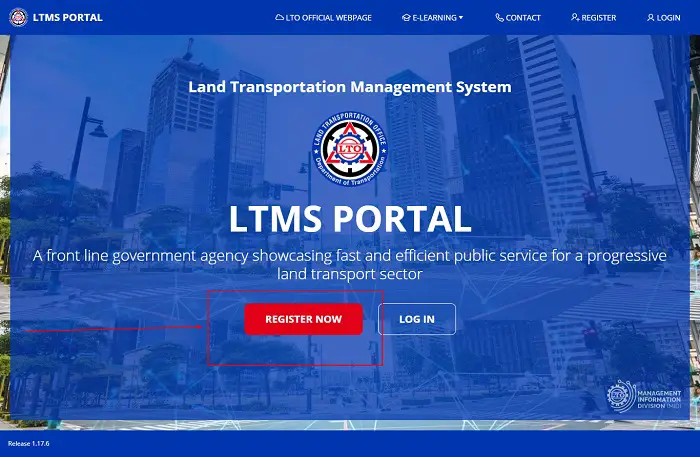
You can access the new LTO website portal here.
You have the option to register or log in. Since this is your first time using the portal, select Register Now.
2. Read and accept the Terms of Agreement
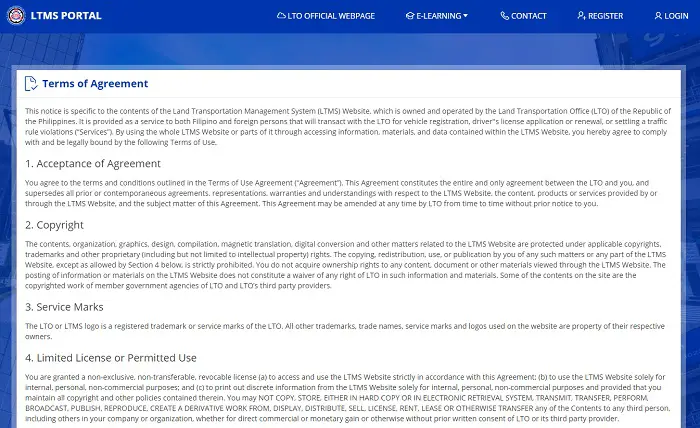
Carefully read the Terms of Agreement. If you accept it, tick the box that says Yes, I accept at the bottom of the page.
Encode the security code in the blank box provided and then click Next.
3. Select ‘Enroll As An Individual’ to proceed with the registration
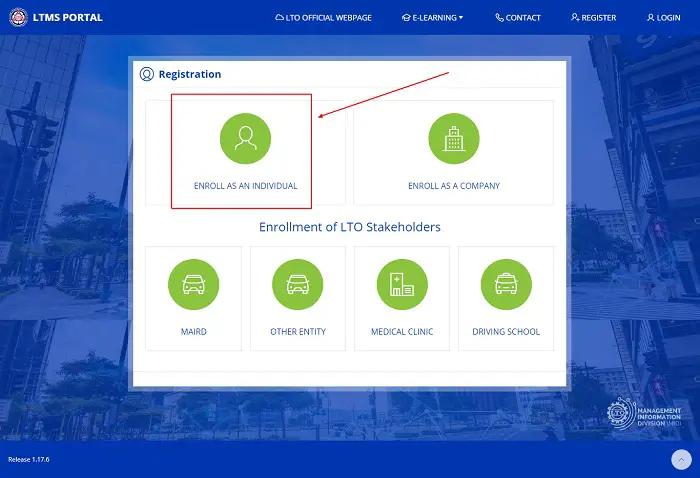
The LTMS portal offers a convenient way to register companies and individual motorists. Since this guide focuses on individual applicants, select Enroll As An Individual.
4. Answer the question on whether you have an existing license or not
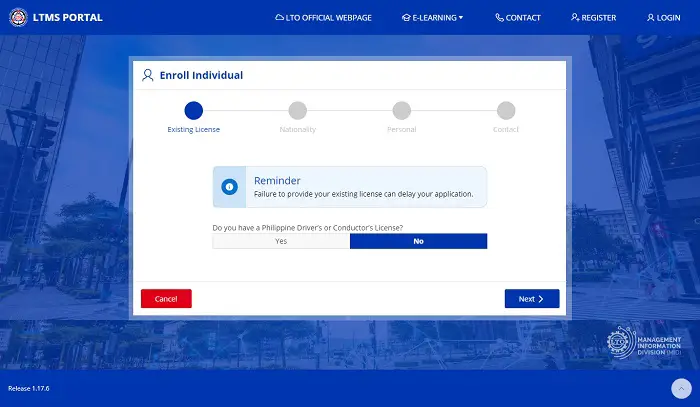
This next page will ask the motorist-applicant a series of questions.
The first question is about Existing License. If you have an existing Philippine driver’s or conductor’s license, select Yes as your answer. You will then be asked to provide the license number, the expiry date, and an answer to the security question. Double-check the information before proceeding to avoid any delay in your application.
Since this guide is for first-timers, let’s assume that you don’t have any existing license yet, in which case, select No as your answer and then click Next to proceed to the second question.
5. Answer the question regarding your nationality
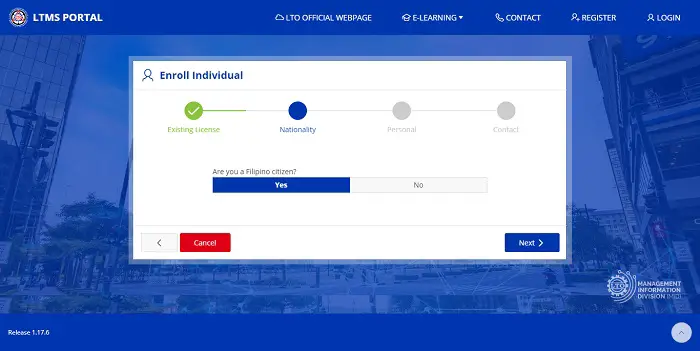
Select Yes to answer the question Are you a Filipino citizen? Otherwise, select No.
If you are a non-Filipino applicant, you must provide your nationality, Alien Certificate of Registration (ACR) Number, and expiration date.
6. Provide your personal details
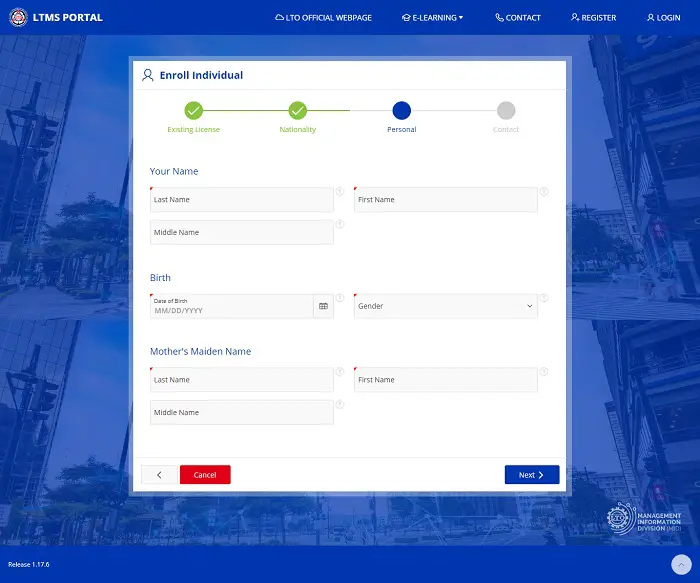
The next section will ask for your details. Fill in the requested information in the boxes provided. These include your name, birth date, gender, and mother’s maiden name.
Once you’re done, click Next.
7. Provide your contact details
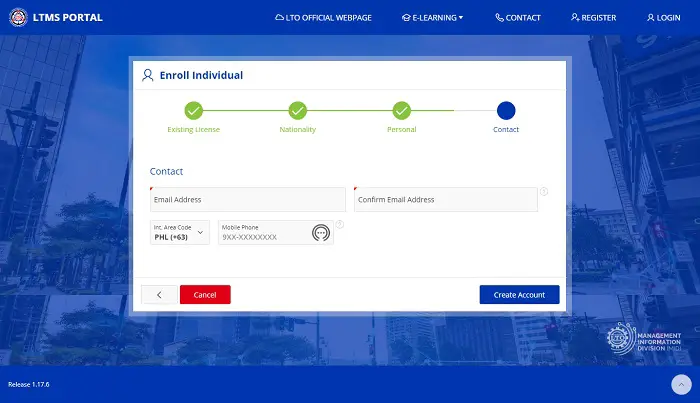
The last question will ask for your email address and phone number. Provide the requested information and click Create Account to proceed to the next step.
8. Click the link sent to your email address to verify your account

You should receive the email almost instantly. If you can’t find it in your inbox, check if it’s in your SPAM folder.
Click the link within 24 hours; otherwise, your account will be automatically deleted.
9. Create your password

The password must follow these guidelines:
- It must have at least eight characters.
- It must contain at least one alphabetic character.
- It must contain at least one number.
- Must have a combination of upper and lower case alphabets.
Once you’re done, click Set Password for Login.
10. Sign in to your account using your new password
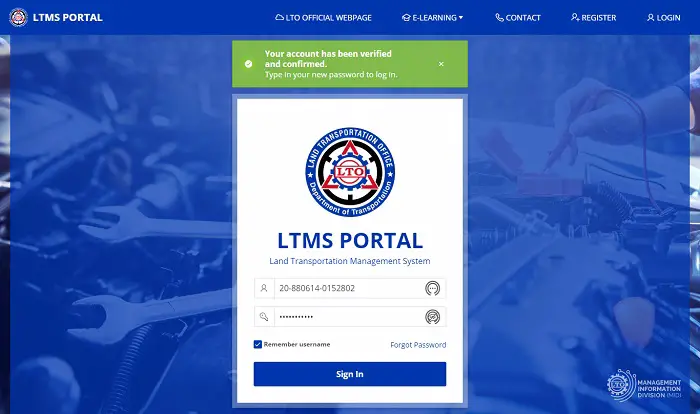
The username is already provided. Since this is the case, don’t forget to tick the box that says Remember username so the system will remember your prefilled username the next time you log in.
11. Select ‘Licensing’ on your dashboard
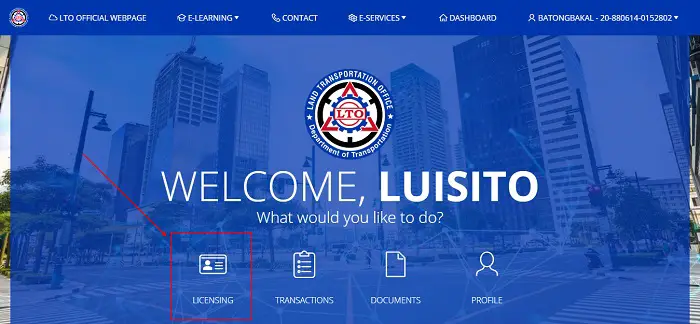
There are four icons you can click, but since you’re applying for a license, select Licensing.
12. Complete your online application form
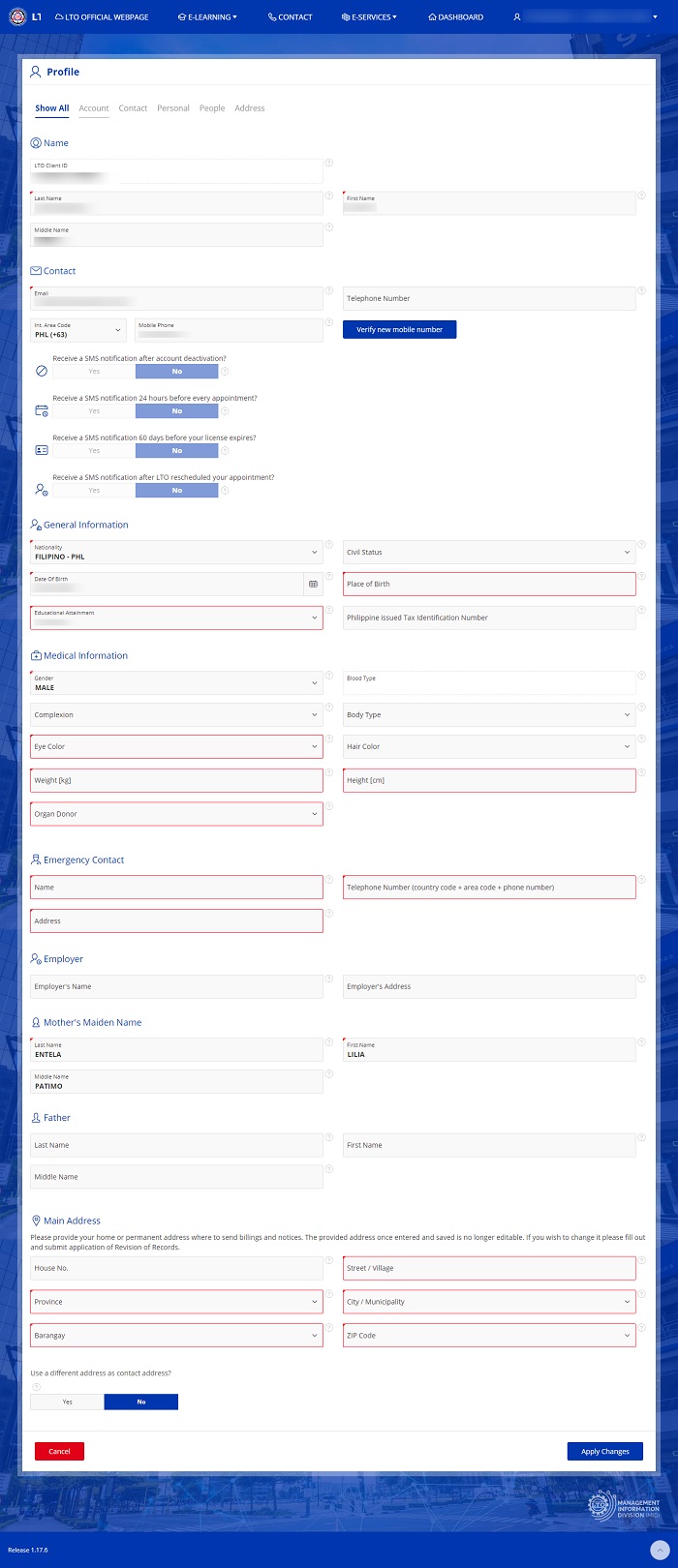
Once inside, you need to fill out the online application form. Some of the questions have already been answered during the previous steps. Complete all the fields with red marks, which are vital in your application.
The vital information includes your educational attainment, place of birth, eye color, height, weight, emergency contact person, and complete address.
When you’re finished, click Apply Changes.
You’ll be redirected to the dashboard. Click Licensing again. Read the Terms of Use and click Accept.
The succeeding steps will then ask you to select the type of license (Student’s License, Driver’s License, or Conductor’s License), the type of application that you want to complete (whether it’s for a new application, renewal, revision of records, application for additional codes, etc.), the appointment schedule you prefer, and the LTO office where you want to process the application.
You can also pay the fees online. However, note that some transactions (like new applications and license renewal) will require you to input your Medical Certificate Number; otherwise, it won’t push through. Therefore, if your transaction includes a medical certificate as one of its requirements, you must have already obtained it before applying online.
How To Prepare for the LTO Driving Test

When applying for a Professional or Non-Professional Driver’s License, you’ll undergo two types of exams: a written examination in the form of the Basic Driving Theory Examination and a practical driving test. You need to pass both to obtain a Driver’s License successfully.
Update: With the goal of improving the quality of drivers and preventing road accidents in the Philippines, the LTO has introduced some changes to how they issue licenses to applicants. As discussed in detail in the Memorandum Circular No. 2019-2176 which was released in late 2019 and became fully implemented on April 6, 2020, the LTO now requires applicants of student driver’s permit to complete at least 15 hours of theoretical driving lessons in LTO or any of its accredited driving schools. Then, in order to be qualified for the Non-Professional or Professional driver’s license, the same applicants will be required to complete at least 8 hours of practical or hands-on driving lessons given by LTO or any LTO-accredited driving school. Just like before, written and practical exams will also be part of the curriculum. For more information, please see the updated list of qualifications for each type of driver’s license above.
1. Written Examination
The written examination will cover the following topics:
- Emergency Situations
- Handling and Driving
- General Information
- Parking Rules and Restrictions
- Penalties and Violations
- Road Positioning
- Signs and Markings
When preparing for both the written and practical driving test, the following files will help you study:
- To review the road traffic signs and pavement markings, refer to this link.
- For a Driver’s License Reviewer in Tagalog, refer to this link.
- For a Non-Professional Driver’s License Reviewer in English, refer to this link.
- For a Professional (Light Vehicles) Driver’s License Reviewer in English, refer to this link.
- For a Professional (Heavy Vehicles) Driver’s License Reviewer in English, refer to this link.
Examination rules:
- If you fail the Basic Driving Theory Examination and/or the Practical Driving Test, you will not be allowed to take the same test within one (1) month from the date of your last examination.
- If you fail the Basic Driving Theory Examination and/or the Practical Driving Test twice within one (1) year, you will not be allowed to take the same test within one (1) year from the date of your last examination.
- If you fail the Basic Driving Theory Examination and/or the Practical Driving Test three times in a row, you will not be allowed to take the same test within two (2) years from the date of your last examination.
- If you fail the exam for additional restriction codes, you can still renew your current license without the additional codes you’ve applied for. The examination results will also be included in your driving record.
2. Practical Driving Test
- During the practical driving exam, there’s an additional fee of ₱250 to rent a car or ₱150 to rent a motorcycle. You can also use your vehicle.
- The complete practical driving test consists of one full driving round at your preferred LTO Office course.
- It’s easy to pass the practical driving, so there’s nothing to be nervous about. Stay calm while driving and follow the instructions on the back of your application form.
- To prepare for the driving test, you can also watch YouTube videos. It will help if you practice reverse parking, too.
- To pass the practical driving test, you must score at least 70 points out of 100.
Penalties And Other Fees Every Philippine Driver Should Know
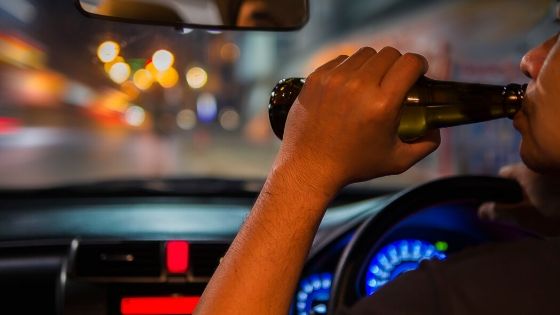
It’s important to be well-informed about traffic rules and driving regulations. Violation of multiple traffic and driving rules may be indicated on your driving record and may even prevent you from processing various driver’s license transactions.
Update: The LTO is now using the point system when dealing with traffic violators. Depending on the type of traffic violation you commit, there is a corresponding number of demerit points that will be assigned/charged to you. Traffic violators who will earn the most demerit points may be required to attend a reorientation course or have their licenses suspended or worse, revoked. Learn more about LTO’s new demerit point system here.
List of Traffic Violations and their Corresponding Fines
- Driving without a valid driver’s license – ₱3,000
- Submitting fake documents in applying for or renewing a driver’s license – ₱3,000
- Falsification of documents, willful misrepresentation of information, cheating during examination, or collusion with LTO officer during license application – ₱20,000
- Driving without a driver’s license, Official Receipt, or Certificate of Registration – ₱1,000
- Driving an unregistered vehicle – ₱10,000
- Committing traffic violations like parking violations, illegal turns, disregarding traffic signs, illegal overtaking, and others – ₱1,000
- Unauthorized modification of vehicle – ₱5,000
- Driving a vehicle with unauthorized, defective, or improper parts, accessories, devices, and equipment – ₱5,000
- Driving a vehicle with an improperly attached or unattached license plate – ₱5,000
- Vehicle renewal or registration fraud – ₱3,000
- Driving under the influence of alcohol and/or dangerous drugs:
- Not resulting in injuries or death – ₱20,000 to ₱80,000
- Resulted in injuries – ₱100,000 to ₱200,000
- Resulted in death – ₱300,000 to ₱500,000
- Reckless Driving:
- First offense – ₱2,000
- Second offense – ₱3,000
- Subsequent offense – ₱10,000
- Driving without a seat belt and/or having a child passenger below six years old on the front passenger seat:
- First offense – ₱1,000
- Second offense – ₱2,000
- Third offense – ₱5,000 + 1 weeks suspension of driver’s license
- Driving without a motorcycle helmet: (tricycle drivers are exempted)
- First offense – ₱1,000
- Second offense – ₱3,000
- Third offense – ₱5,000
- Fourth and subsequent offenses – ₱10,000 + confiscation of driver’s license
- Smoke belching:
- First offense – ₱2,000
- Second offense – ₱4,000
- Third offense – ₱6,000 + 1-year suspension of motor vehicle registration
Underage Drivers
If you’re an underage driver who gets caught and is proven to have misrepresented your age to obtain a driver’s license, you’ll be asked to surrender your current driver’s license.
If you wish to obtain or renew your driver’s license, you must submit an appeal and pay a fine of ₱5,000 plus additional miscellaneous fees.
If you prefer the one (1) year cancellation of license, you must surrender your temporary license, and you’ll be barred from getting a new driver’s license for one (1) year from the day you surrendered your license.
How To Get an International Driver’s License in the Philippines
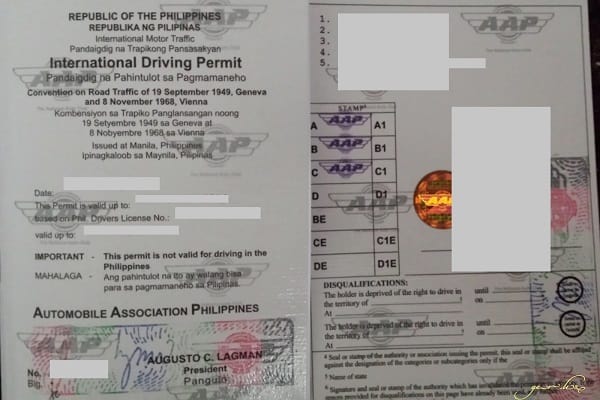
To use your Philippine Driver’s License in other countries, you must apply for a Philippine International Driving Permit at any AAP (Automobile Association of the Philippines, Inc.) Office.
1. Requirements
- Original and photocopy of Professional or Non-Professional Driver’s License (must be valid for at least one year)
- 2 pcs. 2 x 2 colored ID photo (must have a white background)
For foreign nationals, dual citizens, and Filipino citizens born in another country:
- Original passport
- Photocopy of passport information page and page with the date of the last arrival
- Alien Certificate Registration (if permanent resident)
2. Fees
- AAP Joining Fee – ₱300
- AAP Annual Registration – ₱1,200
- PIDP Processing Fee – ₱300
It must be noted that the AAP Joining Fee will be waived for OFWs. You only need to present proof of being an OFW, like a valid Employment Contract and a Seaman’s Passport.
3. How to Apply
Head to the nearest AAP office and submit all the required documents. You can find an AAP office in the following areas (with their corresponding processing time):
- NCR: Alabang: 2 – 3 business days; Makati: 2 – 3 business days; Quezon City: 1 hour
- Luzon: Batangas and Pampanga (2 – 3 business days)
- Visayas: Cebu (4 – 5 business days)
- Mindanao: Davao (4 – 5 business days)
Your Philippine International Driving Permit will be valid for one (1) year from the date of application if your current Philippine Driver’s License is still valid for at least one (1) year. If it’s valid for less than one (1) year, your Philippine International Driving Permit will have the same validity period.
Tips and Warnings
- The government agency now only accepts online medical certificates (instead of hard copies) with the fingerprints of doctors who conducted the physical examination. This move will eradicate “pre-signed” medical certificates illegally issued to applicants without doctors examining them. You can get a medical certificate from a clinic near the LTO office. Still, if it’s closed/unavailable, you can take your medical exam somewhere else, provided it’s on the list of clinics/physicians accredited by LTO.
- The medical certificate is valid for two (2) months. If you apply for a Student Permit and a Non-Pro or Pro Driver’s License within two months, you will only be required to get a medical certificate once.
- To save time and finish early, you can complete the required medical examinations as early as 15 days before the date of application.
- Arrive at your preferred LTO branch early to avoid long lines and to have your transaction processed quickly. LTO Offices and Licensing Centers are open for business from 8:00 AM to 5:00 PM. However, some LTO branches are open as early as 7:00 AM, so if you’re a walk-in applicant, check with the LTO office to know precisely what time they open, and don’t just rely on what’s stated on their Facebook or Google business page. On the other hand, LTO branches inside shopping malls usually open at around 10:00 AM.
- Alternatively, you can also visit the LTO office an hour before closing. Since very few applicants are left, you can finish the application in a short amount of time. This strategy also works for other government offices.
- Schedule an online appointment to accommodate you at any LTO office. Your transaction will also be processed quickly since there will be special lanes for online appointments.
- If possible, apply for license renewal before its expiry date so you won’t have to pay a penalty fee. You’ll also be able to fix any potential issues with your application before it expires.
- Dress appropriately when applying for a new license since your photo will be taken.
- Avoid fixers since you don’t need them. Getting the services of one will only cost you a lot of money and might even result in issues with your license.
- Bring smaller bills and coins, especially if you arrive at the LTO office very early. LTO cashiers still have little to no cash, so they can’t accommodate applicants with larger bills (e.g., ₱1,000) paying relatively smaller application fees.
- Download and accomplish the application form at home so it’ll be ready for submission when you go to an LTO Office.
- Foreigners can get a driver’s license in the Philippines. They can apply for a new Philippine driver’s license or convert their foreign one. If their foreign driver’s license is valid, they can convert it to a Philippine Driver’s License without taking exams. However, if their foreign driver’s license has expired, they’ll have to take the written and practical driving exams before converting their foreign license.
- A driver’s license is one of the major requirements when purchasing a car since the sole reason for a vehicle purchase is to drive it. However, if you are buying the car for a different reason other than to drive it, you can talk to your dealer about it and help you find a solution. Some individuals have purchased cars without a driver’s license but provided a different type of identification.
- Before enrolling in a driving school, verify if it follows the prescribed maximum rate by LTO. This ensures that you’ll not be overcharged for each driving school session. Here are the maximum driving school rates for the Practical Driving Course (PDC) and Theoretical Driving Course (TDC) according to LTO Memorandum Circular No. JMT-2023-239011: For motorcycle (TDC = ₱1,000, PDC = ₱2,500); For light vehicle (TDC = ₱1,000, PDC = ₱4,000); For heavy vehicle (TDC = ₱1,000, PDC = ₱8,000).
Frequently Asked Questions
1. How can I apply for additional Driver’s License (DL) codes?
You can submit an Application for Permits and Licenses (APL) Form at any LTO Licensing Center or District Office that processes driver’s license transactions.
LTO Additional Restriction Code Requirements
a. For both Professional and Non-Professional Driver’s License Holders:
*Fully accomplished APL Form
*Valid Professional or Non-Professional Driver’s License
*Medical examination certificate from LTO-accredited clinic (original and photocopy)*
*Additional Qualifications for specific DL Codes:
i) For those applying for additional DL Code C: Must be a PDL Code B2 holder for at least four years.
ii) For those applying for additional DL Code D: Must be a PDL Code B1 holder for at least four years.
iii) For those applying for additional DL Code BE: Must be a PDL Code B, B1, or B2 holder for at least three years.
iv) For those applying for additional DL Code CE: Must be a PDL Code C or D for at least six months.
LTO Additional Restriction Code Fees
a. For Valid Professional and Non-Professional Driver’s License:
*Application Fee – ₱100
*Computer Fee – ₱67.63
*Replacement Fee – ₱225
*Additional Restriction Fee – ₱100 per additional Restriction Code
*Additional Computer Fee – ₱67.63
b. For Expired Professional and Non-Professional Driver’s License:
*Application Fee – ₱100
*Computer Fee – ₱67.63
*Renewal Fee – ₱585
*Additional Restriction Fee – ₱100 per additional Restriction Code
*Additional Computer Fee – ₱67.63
*Penalty Fee for one (1) Day to one (1) year expired – ₱75
*Penalty Fee for more than one (1) year to two (2) years expired – ₱150
*Penalty Fee for more than two (2) years expired (re-exam) – ₱225
It must be noted that there’s no additional computer fee for RC 1.
LTO Additional DL Code Step-by-step Guide
Step 1: Go to the LTO office and get a queue number.
Step 2: Submit the requirements and wait for the officer to verify your eligibility.
Step 3: Pay the test fees to the Cashier Window.
Step 4: Pass the Computerized Theoretical Exam.
For DL Codes A and A1 (RC 1), no need to take the theoretical exam, only the actual driving test. In case of failing the theoretical exam, your transaction will end.
Step 5: Pass the practical driving test.
In this step, you will drive the vehicle type indicated in your desired additional DL code(s).
Step 6: Complete payment to the Cashier Window.
Step 7: Complete encoding details and biometrics information with the LTO-IT system.
After performing the steps above, you will receive your official receipt and DL card.
Once your application has been approved, your new Professional or Non-Professional License Card will be released, along with the Official Receipt. You’ll be asked to write your name and affix your signature to the Release Form.
2. I applied for a driver’s license but left to work abroad without claiming it. How can OFWs get unclaimed driver’s licenses without returning to the Philippines?
The Land Transportation Office has enabled OFWs working abroad to get their unclaimed driver’s licenses from the Philippine Embassy.
Requirements
Scanned copies of the following documents:
*Fully accomplished Application Form for Unclaimed Driver’s License
*LTO Driver’s License Official Receipt
*2 x 2 picture with blue background
*Passport profile page (must show identification and photo)
*Passport page that shows the arrival stamp in the current country
Step-by-Step Guide
Step 1: Download the application form and fill it out.
Step 2: Scan the fully accomplished application form and other required documents.
Step 3: Send the scanned documents to LTO’s email address: [email protected].
Step 4: Wait for the email notification from LTO indicating the delivery date.
Step 5: Go to your chosen Philippine embassy and claim your Professional or Non-Professional Driver’s License.
3. How can I convert a Non-Professional driver’s license to a Professional driver’s license (and vice versa)?
Change of Classification from Non-Professional to Professional is usually requested if an individual needs to have the authority to drive heavier types of vehicles for employment, personal, or business purposes.
On the other hand, a Change of Classification from Professional to Non-Professional has usually been requested if an individual is not physically fit or doesn’t need the authority to drive heavier vehicles anymore.
You can submit an Application for a Change of Classification at any LTO Licensing Center or District Office that processes Driver’s License transactions.
Requirements
a. From Non-Professional to Professional Driver’s License (and vice versa):
*Fully accomplished Application for Permits and Licenses (APL) Form
*Electronically submitted Medical examination certificates from LTO-accredited clinic (original copy and one photocopy)
*Original valid or expired Driver’s License
Additional Requirements for Non-Professional Driver’s License to Professional Driver’s License only:
*For Non-Professional Driver’s License (NPDL) holders with DL Codes A and A1: The NPDL must be at least six months old since its issuance.
*For NPDL holders with DL Codes B, B1, and B2: The NPDL must be at least one year old since its issuance
*Automated Theoretical Exam
*For Expired NPDL only: Practical Driving test
*Tax Identification Number (TIN)
Note: If you plan to add DL codes alongside your Change of Classification Transaction, you need a Practical Driving Course (PDC) Certificate to proceed with the transaction.
Fees
a. For VALID Non-Professional to Professional and Professional to Non-Professional:
*Application Fee – ₱100
*Computer Fee – ₱67.63
*Replacement Fee – ₱225
*Additional Computer Fee – ₱67.63
*Change Classification Fee – ₱100
b. For EXPIRED Non-Professional to Professional (with the written and practical driving exam) and Professional to Non-Professional (with practical driving exam only):
*Application Fee -₱100
*Computer Fee – ₱67.63
*Renewal Fee – ₱585
*Additional Computer Fee – ₱67.63
*Change Classification Fee – ₱100
*Penalty Fee for one (1) day to one (1) year expired – ₱75
*Penalty Fee for more than one (1) year to two (2) years expired – ₱150
*Penalty Fee for more than two (2) years expired (re-exam) – ₱225
For Delinquent License (Pro to Non-Pro & Non-Pro to Pro; with the written and practical driving exam):
*Application Fee – ₱100
*Computer Fee – ₱67.63
*Renewal Fee – ₱585
*Additional Computer Fee – ₱67.63
*Change Classification Fee – ₱100
*Penalty Fee for more than two (2) years expired (re-exam) – ₱225
Step-by-step Guide
From Non-Professional to Professional Driver’s License (and vice versa):
Step 1: Submit all the required documents for the Change of Classification Application to the receiving personnel at the LTO Office.
Step 2: The receiving personnel will check the documents for completeness and hand them to the evaluator. The evaluator will then review the qualifications of the applicant. If you’re qualified, your application will be encoded in the system.
Step 3: Wait for your name to be called for the photo and signature taking at the designated area.
Step 4: Head to the cashier and pay all the necessary fees when your name gets called.
Step 5: Take the appropriate Basic Driving Theory Test. After the examination, you’ll be informed immediately of the results.
Step 6: If you have passed the written examinations, you must take the Practical Driving Test next. Otherwise, your transaction ends, and you can reapply for a Change of Classification only after a month.
Step 7: After passing both the written examinations and the practical driving test, your application will be approved by the Approving Officer.
Step 8: After the approval, you’ll be issued the new Driver’s License with the Official Receipt. You must write your name and affix your signature to the Release Form.
4. I have changed my name/citizenship/marital status/etc. How can I update my driver’s license and obtain a new one?
You can apply for Revision of Records at any LTO District Office, Licensing Center, and Extension Office that processes Driver’s License transactions.
Basic Requirements
*Fully accomplished Driver’s License Application Form
*Professional or Non-Professional Driver’s License
*Medical examination certificates (online-only/electronically transmitted)
Additional Requirements
a. For Incorrect Name or Birth Date:
*PSA-authenticated birth certificate
*Affidavit of Discrepancy
b. For Change in Name:
*Court Order authorizing the name change
c. For Change in Marital Status:
*Marriage Contract (photocopy) OR;
*Court Order for Annulled or Divorced Applicants
d. For Change in Citizenship:
*Foreign License
*Alien Certificate of Registration
Fees
a. For valid Professional or Non-Professional Driver’s License:
*Replacement Fee – ₱225
*Revision Fee – ₱100
*Computer Fee – ₱67.63
b. For expired Professional or Non-Professional Driver’s License:
*License Fee – ₱585
*Computer Fee – ₱67.63
*Replacement Fee – ₱225
*Revision Fee – ₱100
*Additional Computer Fee – ₱67.63
*Penalty Fee for one (1) day to one (1) year expired – ₱75
*Penalty Fee for more than one (1) year to two (2) years expired – ₱150
*Penalty Fee for more than two (2) years expired (re-exam) – ₱225
c. For dormant Professional or Non-Professional Driver’s Licenses:
*License Fee – ₱585
*Computer Fee – ₱67.63
*Replacement Fee – ₱225
*Revision Fee – ₱100
*Application Fee – ₱100
*Additional Computer Fee – ₱67.63
*Penalty Fee for more than two (2) years expired (re-exam) – ₱225
Step-by-Step Guide
Step 1: At the LTO Office, submit all the required documents for the Revision of Records Application to the receiving personnel.
Step 2: The receiving personnel will check the completeness of your documents and retrieve the license details from the system.
Step 3: Since there will be a revision, you’ll be asked to complete another Driver’s License Application Form for your desired revisions. You may also be asked to submit the appropriate documents related to the revision.
Step 4: The receiving personnel will transmit your documents to the evaluator. The evaluator will review your qualifications; your application will be encoded in the system if qualified.
Step 5: The Approving Officer will approve your application upon encoding.
Step 6: Wait for your name or number to be called for the photo/signature taking.
Step 7: Proceed to the cashier and pay all the necessary fees.
Step 8: You’ll be issued the new Driver’s License and Official Receipt at the Releasing Counter. After obtaining the new license, you must write your name and affix your signature to the Release Form.
5. I need a driver’s license certificate for the job/visa I’m applying for. How can I get one?
You can submit an Application for License Certification at the LTO Central Office Licensing Section and at any LTO Licensing Center or District Office that processes Driver’s License transactions.
Requirements
a. If requested by an individual:
*Current or expired driver’s license (photocopy)
*Fully accomplished Request Slip (should state the purpose)
*Notarized Affidavit of Loss OR;
*Letter Request for Verification of License Data (should state the purpose)
b. If requested by a government agency:
*Current or expired driver’s license (photocopy)
*Letter of Request from the government agency
c. If requested for employment abroad purposes:
*Current or expired driver’s license (original and photocopy)
*Fully accomplished Monitoring Slip
*TIN (Taxpayer’s Identification Number)
Step-by-Step Guide
Step 1: At the LTO Office, head to the Customer Service Counter and submit all the documentary requirements. They’ll be checked for completeness and authenticity.
Step 2: Get and accomplish a monitoring slip.
Step 3: Get a queue number and wait for your turn.
Step 4: Head to the cashier, and once your number gets called, pay all the necessary fees and get your Official Receipt.
Step 5: Head to the Releasing Counter and present the Official Receipt. After claiming your License Certification, you’ll be asked to write your name and affix your signature to the Release Form.
6. Can I use my foreign driver’s license in the Philippines?
Yes. Foreigners with a driver’s license from their country of origin can drive in the Philippines for 90 days after arrival. After 90 days, they must convert their foreign driver’s license to a Philippine driver’s license if they want to continue driving in this country.
7. How can I convert a foreign driver’s license to a Philippine one?
According to LTO, drivers who want to convert their foreign driver’s license to a Philippine driver’s license are no longer required to obtain theoretical and practical driving course certificates as long as they pass the practical exam for applicants of the country that operates right-hand vehicles.
A valid Foreign Driver’s License can be converted only as a Driver’s License with DL Codes A, A1, B, B1, and B2.
Qualifications
*You must be at least eighteen (18) years old.
*You must be physically and mentally able to operate a motor vehicle.
*You must be able to read and write English or Filipino.
*You must have been residing in the Philippines for at least one (1) month and will stay in the country for at least one (1) year from the date of application.
Requirements
a. Fully accomplished Application for Permits and License (APL) Form
b. Medical examination certificate (online-only/electronically transmitted)
c. Valid Visa for at least 120 days upon the arrival date.
d. If the holder of a valid Foreign Driver’s License:
*Valid Foreign Driver’s License (original and photocopy)
*Official English translation of Foreign Driver’s License from Embassy of issuing country, if not in English (original and photocopy)
Step-by-Step Guide
Step 1: Head to the Customer Service Counter and get a Driver’s Application Form and Checklist of Requirements. Get a queue number. It must be noted that you can download the application form and fill it out a day before going to an LTO Office.
Step 2: Wait for your number to be called and submit all the necessary documents to the receiving personnel. Your documents will be checked for completeness and authenticity.
Step 3: Head to the photo/signature-taking area and have your picture and signature taken when your number gets called.
Step 4: Head to the cashier to pay the application fee. Get the Official Receipt.
Step 5: Head to the Releasing Counter to present the Official Receipt and claim your new Driver’s License. Write your name and affix your signature to the Release Form.
8. My driver’s license has been lost/stolen/damaged/mutilated. How can I replace it with a new one?
You can apply for a replacement at any LTO Licensing Center or District Office that processes Driver’s License transactions. Please read this article for a complete guide to requirements, fees, and the replacement process.
9. What are demerit points, and why should drivers avoid getting them?
Demerit points are part of the new point system introduced by the Land Transportation Office (LTO) through the implementing rules and regulations of Republic Act No. 10930.
We’re now adopting the same point system used in most developed countries to improve the overall quality of drivers in the country. In other words, stricter rules = more responsible drivers.
Here’s how it works:
For every traffic violation you accumulate, a corresponding number of demerit points will be assigned or charged to you. The number of demerit points you earn depends on the gravity of the traffic violation you commit. The more serious it is, the more demerit points you’ll get.
Traffic violations have three categories, each of which has been assigned a specific number of demerit points:
As shown in the table above, grave violations will earn the highest number of demerit points because they pose the biggest threat to the safety of the driver, passengers, or the general public and may cause substantial damage to properties.
Traffic violations under this category include driving while under the influence of alcohol and/or drugs; failure to wear seat belt/s; smoke-belching; driving against traffic; driving without a valid driver’s license; and overtaking (upon a curve, at an intersection, at no-overtaking zone, etc.).
Meanwhile, fewer grave violations also endanger people and properties but are not as serious of a threat as grave violations. Included in this classification are failure to dim headlights when approaching another motor vehicle; failure to yield the right to a way to a pedestrian crossing a highway; and failure to stop the motor and notch handbrake or motor vehicle when unattended.
Lastly, light violations are equivalent to only one demerit point because they are minor violations of traffic rules, regulations, laws, and ordinances. Examples are unsafe towing, overcharging/undercharging of fare, and failure to display a “No Smoking” sign inside a passenger vehicle.
Take note that drivers of public utility vehicles (PUVs) will accumulate double demerit points (meaning 2X the regular demerit point) when caught violating a traffic rule while operating a “For Hire” motor vehicle. Double demerit points will also be charged to private motor vehicle drivers operating as a PUV but not authorized by the Land Transportation and Franchising Regulatory Boards (LTFRB).
For a complete list of traffic violations and their corresponding demerit points, view the implementing rules and regulations of R.A. 10930.
What will happen when a driver accumulates demerit points?
The penalty depends on how many demerit points you accumulate within the applicable period, from the date of the initial issuance or last renewal of your driver’s license to the day before your subsequent renewal.
If you are a Student Permit holder and accumulated at least five demerit points, LTO will confiscate and revocate your Student Permit. You’re not allowed to apply for one year. If LTO revokes your SP thrice, you will be perpetually barred from having a license.
For those who accumulate at least five but not more than nine demerit points, you will be required to undergo the Driving Enhancement Program (DEP) from an accredited LTO service provider.
Suppose you get ten demerit points or have committed the same traffic violation at least three times within this period. In that case, you’ll be required to undergo a Driving Enhancement Program (DEP) at the LTO or any accredited service provider. You must also take a Theoretical Exam if you exceed ten demerit points. Aside from this course, PUV drivers who have committed franchise-related violations will also undergo a training seminar conducted by the PUV Driver’s Academy of the LTFRB.
Should the driver refuse or fail to attend the DEP within 30 days from the day he/she was last apprehended, his/her driver’s license will be suspended.
In addition to the above penalties, drivers will also be barred from applying for additional driver’s license codes or applying for a change of classification (from non-professional to professional) within a specific period, the length of which depends on the number of demerit points he/she has accumulated (see table below).
On the other hand, drivers who accumulate 40 demerit points will revoke their driver’s licenses and be disqualified from getting a new license for two years from the date the fines and penalties are settled.
Remember that all your accumulated demerit points will not be carried over once your license has been renewed. Hence, getting a new license means your demerit points will go back to zero, so you can have a fresh start.
References
- Dela Cruz, R. (2020). 10-year license for outstanding drivers, demerits for rogues: LTO. Retrieved 25 August 2020, from https://www.pna.gov.ph/articles/1112960
- Land Transportation Office (LTO). (2021). Memorandum Circular No. 2021-2285. Quezon City.
- LTO scraps periodic medical exam requirement for driver’s license holders (2023). Retrieved from https://www.philstar.com/headlines/2023/04/16/2259347/lto-scraps-periodic-medical-exam-requirement-drivers-license-holders
- Department of Transportation (DOT). (2021). Supplemental Implementing Rules and Regulations of Republic Act No. 10930 (Guidelines and Procedures Governing the Issuance of Student’-Driver’s Permit, Conductor’s License, and Driver’s License).
- Land Transportation Office (LTO) Citizen’s Charter. (2019). [Ebook] (3rd ed.).
- List of LTO-Accredited Medical Clinics and Registered Physicians. (2019). Retrieved 29 June 2020, from https://www.lto.gov.ph/list-of-accredited-clinics.html
- LTO sets P300 rate for medical exam in license application(2023). Retrieved from https://www.pna.gov.ph/articles/1201961
- Cabrera, R. (2022, December 04). LTO relaunches driver’s Education Center. Retrieved February 3, 2023, from https://www.philstar.com/headlines/2022/12/04/2228372/lto-relaunches-drivers-education-center
- Paano kumuha ng Professional Driver’s License | Requirements | Non pro to pro | Latest | 2023 | LTO [Video file]. (2022, March 17). Retrieved February 3, 2023, from https://youtu.be/Wso4lCoOYUs?t=255
- Lalu, G. (2020). LTO opens an online portal for payment of car registration, license application. Retrieved 27 June 2020, from https://newsinfo.inquirer.net/1288187/lto-opens-online-portal-for-car-registration-payment-to-avoid-covid-19-transmissions
- Dela Cruz, R. C. (2023). LTO sets standard fees, cuts the duration for driving courses. Retrieved from https://www.pna.gov.ph/articles/1197985
Written by Luisito Batongbakal Jr.
in Government Services, Juander How, LTO, Vehicles and Transportation
Last Updated
Luisito Batongbakal Jr.
Luisito E. Batongbakal Jr. is the founder, editor, and chief content strategist of FilipiKnow, a leading online portal for free educational, Filipino-centric content. His curiosity and passion for learning have helped millions of Filipinos around the world get access to free insightful and practical information at the touch of their fingertips. With him at the helm, FilipiKnow has won numerous awards including the Top 10 Emerging Influential Blogs 2013, the 2015 Globe Tatt Awards, and the 2015 Philippine Bloggys Awards.
Copyright Notice
All materials contained on this site are protected by the Republic of the Philippines copyright law and may not be reproduced, distributed, transmitted, displayed, published, or broadcast without the prior written permission of filipiknow.net or in the case of third party materials, the owner of that content. You may not alter or remove any trademark, copyright, or other notice from copies of the content. Be warned that we have already reported and helped terminate several websites and YouTube channels for blatantly stealing our content. If you wish to use filipiknow.net content for commercial purposes, such as for content syndication, etc., please contact us at legal(at)filipiknow(dot)net
